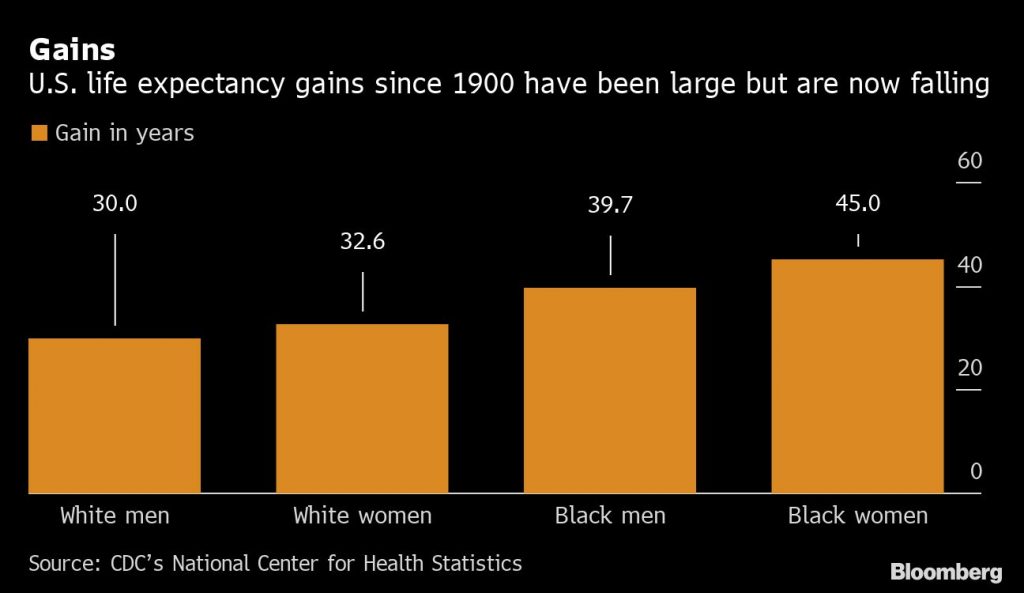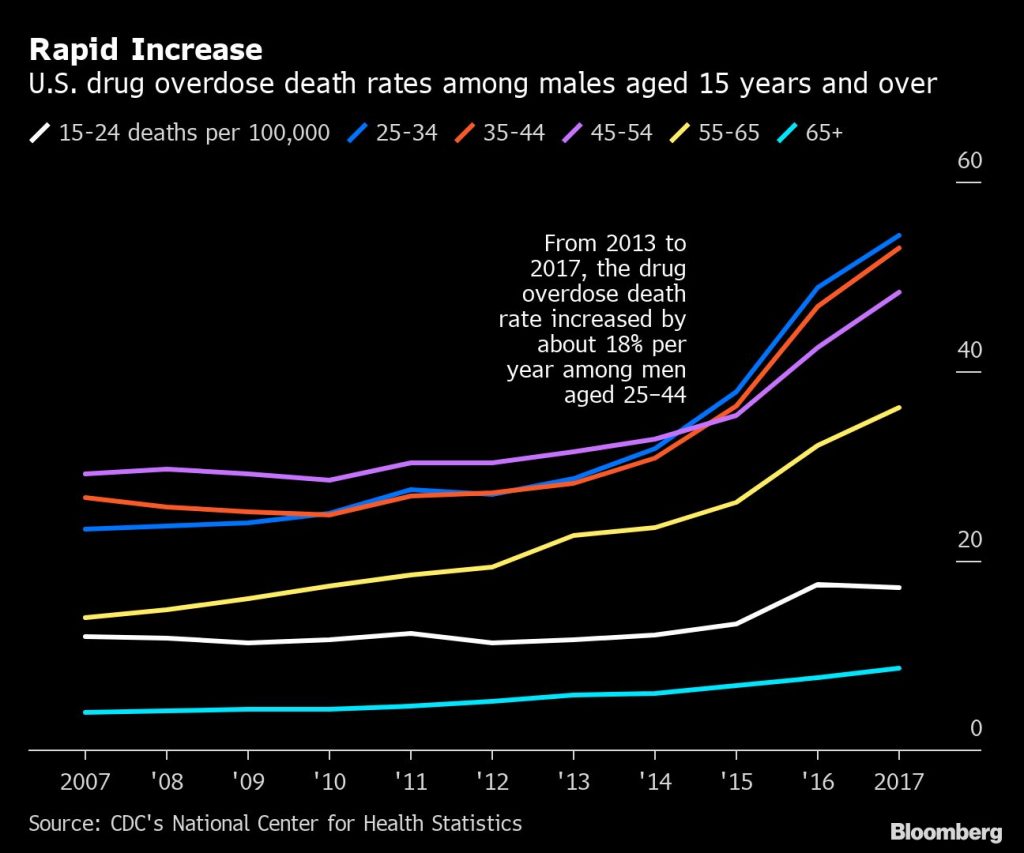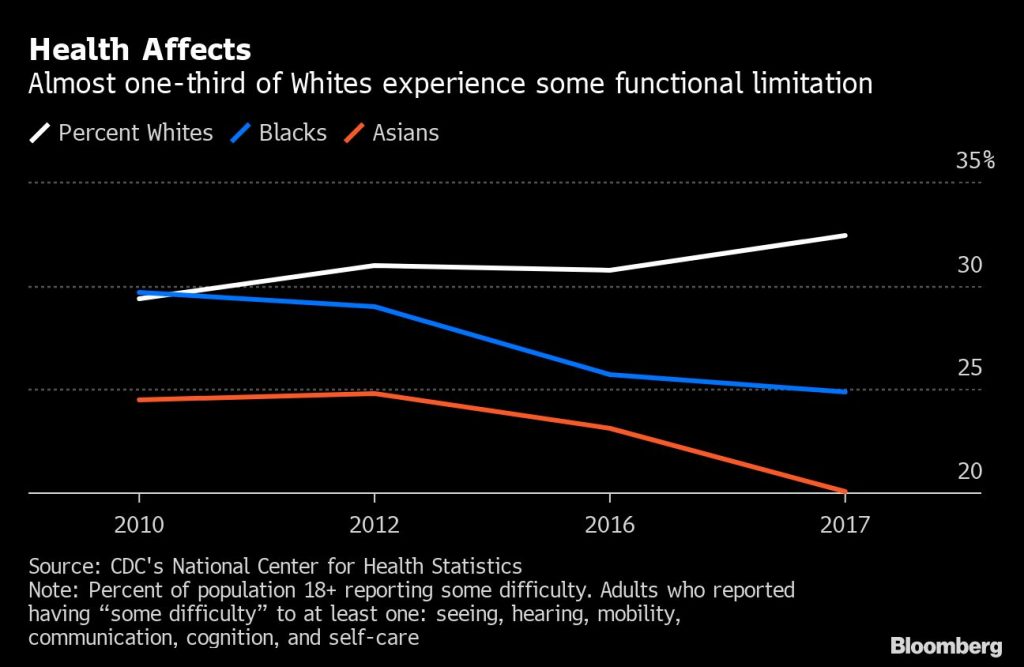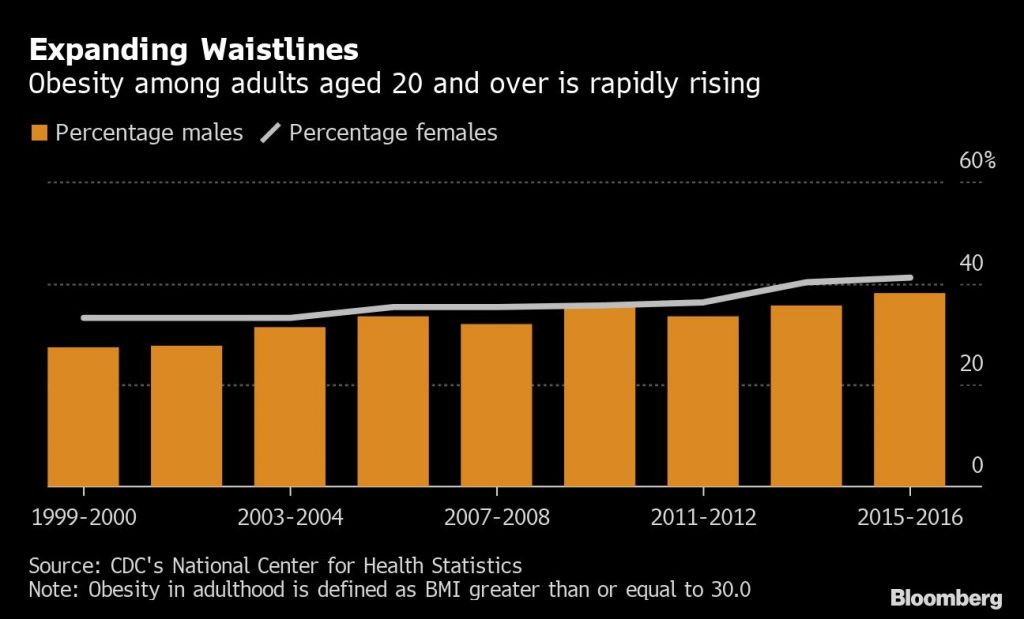 The number ofadults age 65 and over struggling with poor health, which impactsfamilies and increases pressure on health services and social care,increased from 14.7 million in 2010 to 20.4 million in 2017.(Photo: Shutterstock)
The number ofadults age 65 and over struggling with poor health, which impactsfamilies and increases pressure on health services and social care,increased from 14.7 million in 2010 to 20.4 million in 2017.(Photo: Shutterstock)
(Bloomberg)–Signs of declining health for American men abound inthe National Center for Health Statistics latest annual report.
|Life expectancy at birth for males declined to76.1 years in 2017 from 76.5 in 2014, according to the data. At age65, men are projected to live another 18.1 years compared with 20.6years for women.
|These and other takeaways from the annual report, which tracksthe health of the U.S. population across different metrics, haveimplications for productivity, wages and the broader economy.
|Related: Climate change brings catastrophic health carecosts
|Here are some other highlights from the report released on Oct.30.
|Life expectancy
Life expectancy has been falling across demographics in America.The estimates for whites, blacks and Hispanics fell to 78.5, 74.9and 81.8 respectively by 2017, after having peaked in 2012 or 2014for those groups.
|
The decline in life expectancy is occurring in part due todeaths from despair. From 2007 to 2017, the mortality rate fromdrug overdoses increased 82 percent, to 21.7 deaths from11.9 per 100,000. Over the same 10-year period, suicide ratesincreased 24 percent, to 14.0 deaths from 11.3 per 100,000resident population.
|Males had twice the female drug overdose death rate in 2017 andrates for men have virtually doubled since 2007. The recentincreases were especially pronounced among men aged 25–34 and35–44, the report shows.
|
While drug overdose rates per 100,000 are considerably lower forfemales, in recent years younger age groups have seen a markedincrease. The drug overdose death rate increased around17 percent per year among females aged 15–34 years.
|Suicides among Americans have also increased sharply — from26,869 in 1980 to 47,173 in 2017. In 2017, it was the secondleading cause of death, behind accidents, for young age groups —10–14, 15–19, and 20–24 — and it reached a record high, withyounger males in particular strongly impacted.
Poor health
Many Americans are suffering from poor health. About one thirdof adults suffer from a condition that limits functionality, whichis a concern as the population ages. The number of adults age 65and over struggling with poor health, which impacts families andincreases pressure on health services and social care, increasedfrom 14.7 million in 2010 to 20.4 million in 2017.
|
The use of e-cigarettes among high school students, grades ninethrough 12, has soared this decade to 20.8 percent in 2018from 1.5 percent in 2011. The rate has almost doubled inthe last year alone from from 11.7 percent in 2017, thedata show.
|Obesity
From 1999–2000 to 2015–2016, the age-adjusted prevalence ofobesity among men increased from 27.4 percent to38.1 percent. For American woman, the situation is evenworse — the prevalence of obesity among them increased from33.3 percent to 41.2 percent.
|Adult obesity is correlated with higher death rates as it oftenis associated with increases in hypertension, high cholesterollevels, type 2 diabetes, and other health conditions which limitones functionality such as asthma, sleep apnea, and jointproblems.
|
Many problems associated with poor health stem from lowerincomes.
|Adults with low income were more likely to delay, or notreceive, needed medical care due to cost. While7.4 percent of Americans delayed or did not receive neededmedical care due to the cost involved, that figure is down from10.9 percent in 2010. On a per capita basis, Americansspent $10,739 on health expenditures in 2017.
|There is some good news in the report too. Though heart diseaseremains the most common cause of death — death rates from heartdisease and cancer have dropped by about 15 percentbetween 2007 to 2017. Deaths from strokes for both men and womenare down 13.6 percent, mainly due to better prevention,diagnosis and treatment, according to the report.
|Read more:
- Are Americans really thatunhealthy?
- 5 steps to integrate social determinants of healthinto our health care system
- Millennials face greater risk of obesity-relatedcancer than Boomers
Copyright 2019 Bloomberg. All rightsreserved. This material may not be published, broadcast, rewritten,or redistributed.
Complete your profile to continue reading and get FREE access to BenefitsPRO, part of your ALM digital membership.
Your access to unlimited BenefitsPRO content isn’t changing.
Once you are an ALM digital member, you’ll receive:
- Critical BenefitsPRO information including cutting edge post-reform success strategies, access to educational webcasts and videos, resources from industry leaders, and informative Newsletters.
- Exclusive discounts on ALM, BenefitsPRO magazine and BenefitsPRO.com events
- Access to other award-winning ALM websites including ThinkAdvisor.com and Law.com
Already have an account? Sign In
© 2024 ALM Global, LLC, All Rights Reserved. Request academic re-use from www.copyright.com. All other uses, submit a request to [email protected]. For more information visit Asset & Logo Licensing.








